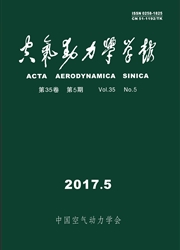

 中文摘要:
中文摘要:
表面热流的反演是一类典型的热传导逆问题。在采用有限体积法数值求解三维非稳态热传导问题的基础上,将该热传导逆问题转化为优化问题,建立了顺序函数法和共轭梯度法这两类反演算法。采用这两类算法对一个典型算例的计算结果表明:建立的两类反演算法都是有效的,具有较好的抗噪性能。顺序函数法的优势在于算法的推导和实现较为简便,但算法中存在人为确定的参数r,该参数的选取对反演结果有较大影响。共轭梯度法的算法中没有自由参数,但算法的推导和实现都较为复杂,其反演结果的精度和顺序函数法的反演结果精度基本相当。
 英文摘要:
英文摘要:
Inverse estimation of surface heat flux for three-dimensional transient heat conduction problem from temperature measurements is a typical Inverse Heat Conduction Problem(IHCP). In this paper, based on the numerical simulation of three-dimensional transient heat conduction problem with the Finite Volume Method(FVM), this IHCP is converted to a parameter optimization problem and two estimation methods, Sequential Function Method(SFM) and Conjugate Gradient Method(CGM), are developed. After applying these two methods to a typical exemplified case, it can be seen that both estimation methods are feasible and not sensitive to the measurement noise. The advantage of the SFM lies in that the formulation and programming of SFM is straightforward and relatively easy. But there is a parameter of r need to be carefully selected because this parameter plays an important role on the inversion result. On the other hand, there is no free parameter in the CGM, but the deduction and programming of CGM is complicated and the estimated result of CGM is of comparable accuracy with the estimated result of SFM.
 同期刊论文项目
同期刊论文项目
 同项目期刊论文
同项目期刊论文
 期刊信息
期刊信息
